- Sunbittern
Taxobox
name = Sunbittern

image_width = 250px
image_caption = Displaying bird
status = LC | status_system = IUCN3.1
regnum =Animal ia
phylum =Chordata
classis =Aves
ordo =Gruiformes (but see article)
familia = Eurypygidae
familia_authority = Selby,1840
genus = "Eurypyga"
genus_authority = Illiger,1811
species = "E. helias"
binomial = "Eurypyga helias"
binomial_authority = Pallas,1781 The Sunbittern, "Eurypyga helias" is a
bittern -likebird of tropical regions of theAmericas , and the sole member of the family Eurypygidae (sometimes spelled Eurypigidae) andgenus "Eurypyga".Biology
The Sunbittern is normally found near wooded streams or creeks at elevations of up to 909 m. It hunts fish and other small
vertebrate s much in the same way asheron s do. The bird has a generally subdued coloration, with fine linear patterns of black, grey and brown. Itsremiges however have vividly-colored middle webs, which with wings fully spread show bright eyespots in red, yellow, and black. These are shown to other sunbitterns in courtship and threat displays, or used to startle potential predators. Like some other birds, the Sunbittern haspowder down .They build domed nests in trees, and lay two eggs with blotched markings. The young are
precocial , but remain in the nest for several weeks after hatchingcite book |editor=Forshaw, Joseph|author= Archibald, George W.|year=1991|title=Encyclopaedia of Animals: Birds|publisher= Merehurst Press|location=London|pages= 100|isbn= 1-85391-186-0] .Taxonomy
The sunbittern is usually placed in the Gruiformes, but this was always considered preliminary. In some aspects of its morphology the Sunbittern is close to the herons and their relatives (which include
bittern s), but this appears to beconvergent evolution due to similar lifestyles. Altogether, the bird is most similar to another enigmatic bird provisionally placed in the Gruiformes, theKagu . Molecular studies (e.g. Fain & Houde 2004) seem to confirm that the Kagu and Sunbittern are each other's closest living relatives. They are probably not Gruiformes (though the proposedMetaves are just as weakly supported). Altogether, the two species seem to form a minorGondwana n lineage which possibly also includes the extinctadzebill s and/or themesite s, and is of unclear relation to the Gruiformes proper. Notably, the Kagu and mesites also have powder down.The rather comprehensive DNA study by Hackett "et al" [Hackett, S. "et al" (2008) "A Phylogenomic Study of Birds Reveals Their Evolutionary History " "Science" 320 (5884) 1763 - 1768] confirms that the sunbittern and the Kagu are close relatives but rather surprisingly it puts these two as a sister group of the swifts, nightjars and hummingbirds.
References
* Database entry includes justification for why this species is of least concern
* Fain, Matthew G. & Houde, Peter (2004): Parallel radiations in the primary clades of birds. "Evolution" 58(11): 2558-2573. doi|10.1554/04-235 [http://biology-web.nmsu.edu/houde/Parallel_radiations.pdf PDF fulltext]
External links
* [http://www.birdlife.org/datazone/species/index.html?action=SpcHTMDetails.asp&sid=2758&m=0 BirdLife Species Factsheet]
* [http://ibc.hbw.com/ibc/phtml/especie.phtml?idEspecie=1329 Sunbittern videos] on the Internet Bird Collection
* [http://www.cpzbook.com/sunbittern.jpgDisplaying Sunbittern] atCentral Park Zoo . Photo by Ferne Spieler.
Wikimedia Foundation. 2010.
